The Automotive Brake Fluid Market is estimated to be valued at USD 1.4 billion in 2025 and is projected to reach USD 2.3 billion by 2035, registering a compound annual growth rate (CAGR) of 4.9% over the forecast period.
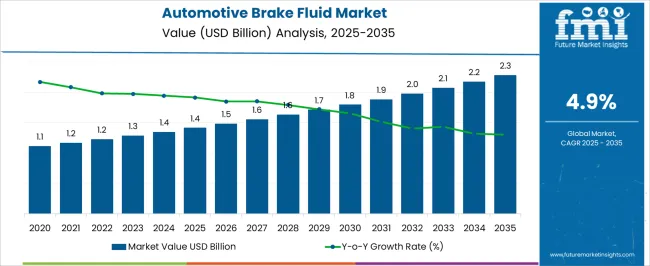
| Metric | Value |
|---|---|
| Automotive Brake Fluid Market Estimated Value in (2025 E) | USD 1.4 billion |
| Automotive Brake Fluid Market Forecast Value in (2035 F) | USD 2.3 billion |
| Forecast CAGR (2025 to 2035) | 4.9% |
The Automotive Brake Fluid market is experiencing consistent growth, supported by rising global vehicle production and the increasing demand for reliable braking systems that ensure passenger safety. Brake fluid plays a critical role in transmitting force under high temperatures and pressures, making it essential for the smooth operation of modern braking systems. Growing regulatory emphasis on safety standards, combined with technological advancements in braking systems such as anti-lock braking systems and electronic stability control, is accelerating demand.
Expanding fleets of passenger cars, commercial vehicles, and two-wheelers across emerging markets are further contributing to market expansion. Rising awareness about vehicle maintenance and the replacement cycle of brake fluids is also driving adoption in the aftermarket.
Additionally, advancements in fluid formulations that offer better resistance to boiling, corrosion protection, and compatibility with advanced materials are shaping the competitive landscape As global mobility continues to expand and automotive technologies evolve, the demand for efficient and durable brake fluids is expected to grow steadily, supported by stringent safety norms and increasing vehicle parc.
The automotive brake fluid market is segmented by type, base, and geographic regions. By type, automotive brake fluid market is divided into DOT 3 (Glycol Ether Based), DOT 4 (Glycol Ether Based/Borate Ester), DOT 5 (Silicone Based), and DOT 5.1 (Borate Ester/Glycol Ether). In terms of base, automotive brake fluid market is classified into Petroleum and Non-Petroleum. Regionally, the automotive brake fluid industry is classified into North America, Latin America, Western Europe, Eastern Europe, Balkan & Baltic Countries, Russia & Belarus, Central Asia, East Asia, South Asia & Pacific, and the Middle East & Africa.
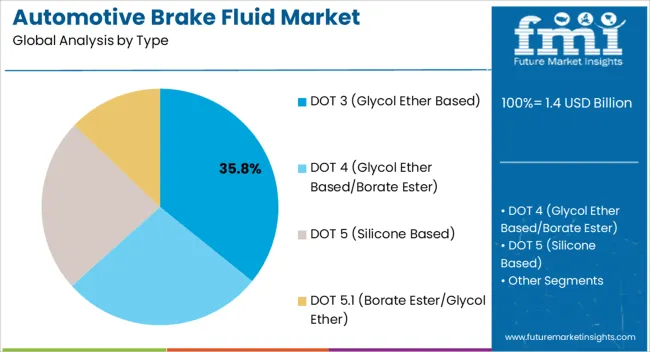
The DOT 3 type segment is projected to hold 35.8% of the Automotive Brake Fluid market revenue in 2025, positioning it as a leading product category. DOT 3 brake fluids, primarily composed of glycol ether-based formulations, are widely adopted due to their affordability, availability, and compatibility with conventional braking systems. They are particularly suitable for vehicles operating in normal driving conditions where high-performance specifications are not required.
Their cost-effectiveness has made them the preferred choice in emerging markets, where vehicle affordability and maintenance costs are key considerations. Although newer variants such as DOT 4 and DOT 5.1 are gaining traction in high-performance applications, DOT 3 continues to maintain a strong foothold due to its established use in large vehicle segments.
The widespread presence of DOT 3 in the aftermarket, combined with lower replacement costs and ease of accessibility, is ensuring its sustained demand As emerging economies expand their vehicle fleets, the segment’s affordability and reliability are expected to drive continued adoption, reinforcing its steady share of the market.
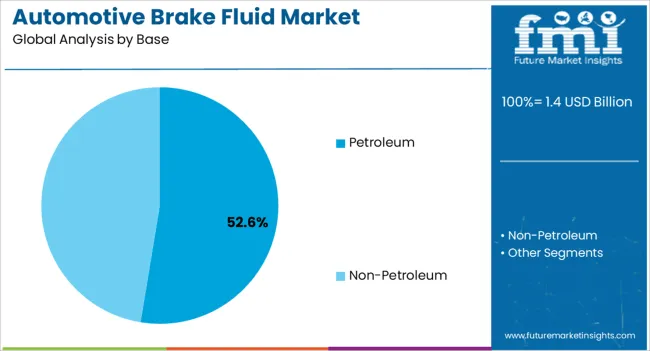
The petroleum base segment is anticipated to account for 52.6% of the Automotive Brake Fluid market revenue in 2025, making it the leading base type. Petroleum-based formulations are preferred due to their effective performance under a wide range of temperatures and their ability to provide consistent lubrication and protection within braking systems. Their dominance is supported by extensive usage in mass-market vehicles, where cost efficiency and reliable performance are critical factors.
Petroleum-based brake fluids are widely adopted by automotive manufacturers and aftermarket service providers because they balance affordability with adequate protection against wear, corrosion, and heat-induced degradation. Additionally, advancements in refining and additive technologies have enhanced the stability and safety of petroleum-based formulations, reinforcing their relevance in both developing and developed markets.
The large-scale production capabilities and established supply chains for petroleum-based fluids are further strengthening their market share As global vehicle ownership increases, particularly in cost-sensitive regions, the petroleum base segment is expected to retain its leadership, driven by high volume adoption and proven performance.
In the automotive market, initially mechanical brakes were used which were gradually replaced by hydraulic brakes, where brake fluid was required. The first hydraulic system was developed in 1914 by Frederick Duesenberg, an American automotive pioneer.
Today, most automotive brake fluid is either silicone based (DOT5) or glycol based (DOT3).
Most drivers check their engine oil or tire pressure regularly, but very often drivers check the brake fluid in their vehicle. Automotive brake fluid is a type of hydraulic fluid used in hydraulic clutches & brake applications in motorcycles, automobiles and some bicycles.
It plays a crucial role as it transfers force when a driver applies the brake. Additionally, automotive brake fluid helps prevent corrosion and serves as lubricant for all movable parts.
Automotive brake fluids, across the world, are regulated products and need to meet certain specifications and recommendations set by industry agencies and associations such as the Society of Automotive Engineers (SAE), Japanese Standards Association (JSA the International Organization for Standardization (ISO), USA Federal Motor Vehicle Safety Standards and Regulations (FMVSS), USA Department of Transportation (DOT) and GB12981-2003 in China.
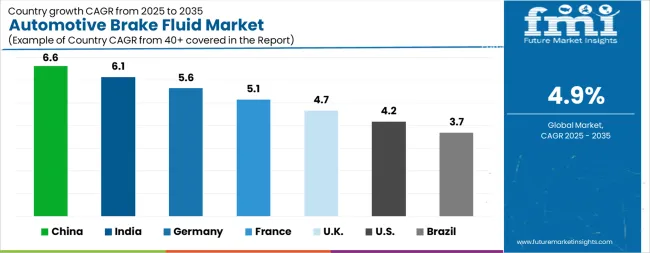
| Country | CAGR |
|---|---|
| China | 6.6% |
| India | 6.1% |
| Germany | 5.6% |
| France | 5.1% |
| UK | 4.7% |
| USA | 4.2% |
| Brazil | 3.7% |
The Automotive Brake Fluid Market is expected to register a CAGR of 4.9% during the forecast period, exhibiting varied country level momentum. China leads with the highest CAGR of 6.6%, followed by India at 6.1%. Developed markets such as Germany, France, and the UK continue to expand steadily, while the USA is likely to grow at consistent rates. Brazil posts the lowest CAGR at 3.7%, yet still underscores a broadly positive trajectory for the global Automotive Brake Fluid Market. In 2024, Germany held a dominant revenue in the Western Europe market and is expected to grow with a CAGR of 5.6%. The USA Automotive Brake Fluid Market is estimated to be valued at USD 530.9 million in 2025 and is anticipated to reach a valuation of USD 798.4 million by 2035. Sales are projected to rise at a CAGR of 4.2% over the forecast period between 2025 and 2035. While Japan and South Korea markets are estimated to be valued at USD 74.1 million and USD 45.8 million respectively in 2025.
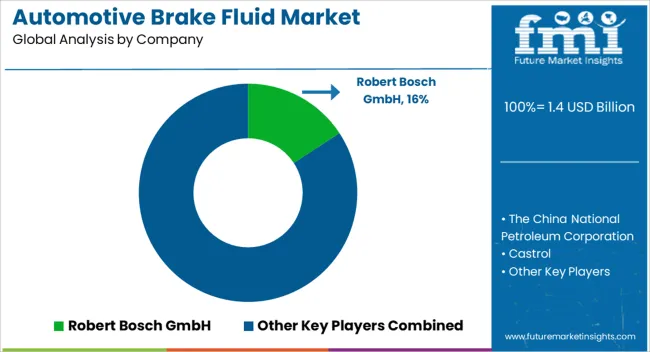
| Item | Value |
|---|---|
| Quantitative Units | USD 1.4 Billion |
| Type | DOT 3 (Glycol Ether Based), DOT 4 (Glycol Ether Based/Borate Ester), DOT 5 (Silicone Based), and DOT 5.1 (Borate Ester/Glycol Ether) |
| Base | Petroleum and Non-Petroleum |
| Regions Covered | North America, Europe, Asia-Pacific, Latin America, Middle East & Africa |
| Country Covered | United States, Canada, Germany, France, United Kingdom, China, Japan, India, Brazil, South Africa |
| Key Companies Profiled | Robert Bosch GmbH, The China National Petroleum Corporation, Castrol, Exxon Mobil Corporation, Fuchs Petrolub SE, Royal Dutch Shell plc, China Petroleum & Chemical Corporation, Total S.A., Chevron Corporation, and Qingdao Copton Technology Company Limited |
The global automotive brake fluid market is estimated to be valued at USD 1.4 billion in 2025.
The market size for the automotive brake fluid market is projected to reach USD 2.3 billion by 2035.
The automotive brake fluid market is expected to grow at a 4.9% CAGR between 2025 and 2035.
The key product types in automotive brake fluid market are dot 3 (glycol ether based), dot 4 (glycol ether based/borate ester), dot 5 (silicone based) and dot 5.1 (borate ester/glycol ether).
In terms of base, petroleum segment to command 52.6% share in the automotive brake fluid market in 2025.






Our Research Products

The "Full Research Suite" delivers actionable market intel, deep dives on markets or technologies, so clients act faster, cut risk, and unlock growth.

The Leaderboard benchmarks and ranks top vendors, classifying them as Established Leaders, Leading Challengers, or Disruptors & Challengers.

Locates where complements amplify value and substitutes erode it, forecasting net impact by horizon

We deliver granular, decision-grade intel: market sizing, 5-year forecasts, pricing, adoption, usage, revenue, and operational KPIs—plus competitor tracking, regulation, and value chains—across 60 countries broadly.

Spot the shifts before they hit your P&L. We track inflection points, adoption curves, pricing moves, and ecosystem plays to show where demand is heading, why it is changing, and what to do next across high-growth markets and disruptive tech

Real-time reads of user behavior. We track shifting priorities, perceptions of today’s and next-gen services, and provider experience, then pace how fast tech moves from trial to adoption, blending buyer, consumer, and channel inputs with social signals (#WhySwitch, #UX).

Partner with our analyst team to build a custom report designed around your business priorities. From analysing market trends to assessing competitors or crafting bespoke datasets, we tailor insights to your needs.
Supplier Intelligence
Discovery & Profiling
Capacity & Footprint
Performance & Risk
Compliance & Governance
Commercial Readiness
Who Supplies Whom
Scorecards & Shortlists
Playbooks & Docs
Category Intelligence
Definition & Scope
Demand & Use Cases
Cost Drivers
Market Structure
Supply Chain Map
Trade & Policy
Operating Norms
Deliverables
Buyer Intelligence
Account Basics
Spend & Scope
Procurement Model
Vendor Requirements
Terms & Policies
Entry Strategy
Pain Points & Triggers
Outputs
Pricing Analysis
Benchmarks
Trends
Should-Cost
Indexation
Landed Cost
Commercial Terms
Deliverables
Brand Analysis
Positioning & Value Prop
Share & Presence
Customer Evidence
Go-to-Market
Digital & Reputation
Compliance & Trust
KPIs & Gaps
Outputs
Full Research Suite comprises of:
Market outlook & trends analysis
Interviews & case studies
Strategic recommendations
Vendor profiles & capabilities analysis
5-year forecasts
8 regions and 60+ country-level data splits
Market segment data splits
12 months of continuous data updates
DELIVERED AS:
PDF EXCEL ONLINE
Automotive Brake Linings Market Size and Share Forecast Outlook 2025 to 2035
Automotive Brake Hoses and Assemblies Market Size and Share Forecast Outlook 2025 to 2035
Automotive Brake Booster and Master Cylinder Market Size and Share Forecast Outlook 2025 to 2035
Automotive Brake Actuation Systems Market Size and Share Forecast Outlook 2025 to 2035
Automotive Brake Shims Market Analysis - Size, Share, and Forecast 2025 to 2035
Automotive Brake System Market Growth - Trends & Forecast 2025 to 2035
Automotive Brake Friction Products Market - Trends & Forecast 2025 to 2035
Automotive Brake Pad Market - Growth & Demand 2025 to 2035
Automotive Brake Tube Market Growth - Trends & Forecast 2025 to 2035
Automotive Brake Valve Market Growth - Trends & Forecast 2025 to 2035
Automotive Brake System & Components Market Growth - Trends & Forecast 2025 to 2035
Automotive Handbrake And Clutch Cables Market
Automotive Park Brake Lever Market Growth – Trends & Forecast 2024-2034
Automotive Vacuum Brake Booster Market Size and Share Forecast Outlook 2025 to 2035
Automotive Carbon Brake Rotors Market Growth - Trends & Forecast 2025 to 2035
Automotive Sintered Brake Pads Market Size and Share Forecast Outlook 2025 to 2035
Automotive Carbon Ceramic Brake Market Size and Share Forecast Outlook 2025 to 2035
Automotive Direct Liquid Cooling IGBT Module Market Size and Share Forecast Outlook 2025 to 2035
Automotive Hoses and Assemblies Market Size and Share Forecast Outlook 2025 to 2035
Brake Pads and Shoes Market Size and Share Forecast Outlook 2025 to 2035

Thank you!
You will receive an email from our Business Development Manager. Please be sure to check your SPAM/JUNK folder too.
Chat With
MaRIA